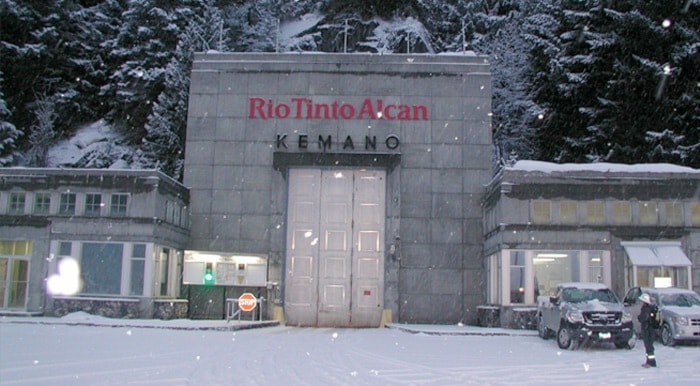Submissions over how much Rio Tinto Alcan should be fined after being found guilty of killing salmon continued last week in Terrace court.
The company was originally charged with one count each of harmful alteration of fish habitat and destruction of fish, two violations of the Federal Fisheries Act, from an event at Kemano where its hydroelectric facilities powering its Kitimat aluminum smelter are located.
Those charges stem from an April 14, 2011 incident in which the company decreased the water supply to the Kemano River, a move that followed an emergency request made by BC Hydro regarding repairs the crown corporation needed to make.
Rio Tinto was found guilty by provincial court judge Calvin Struyk a year ago and lawyers for the parties were before him last week regarding the size of a fine and other matters.
Penalties imposed on the company could be fines of up to $1,000,000, up to six months in jail for the company’s officials or both.
With eulachon and salmon in the Kemano River, and the importance of the eulachon to the Haisla people, Alcan had an agreement with the Haisla to give the eulachon priority.
But in focusing on the eulachon, salmon weren’t considered, said Struyk in his March 2015 decision.
That decision was released from a trial that took place over several days in May and October 2014.
In its own statement of May 13, 2013, BC Hydro said it asked Rio Tinto Alcan to cut the flow of water into the Kemano River, which would mean less water going through its generators to produce electricity, because of a “hot spot,” a bad connection on a transmission line that had heated up and was in danger of melting the connection.
The transmission lines of Rio Tinto Alcan and BC Hydro are connected so that if the connection had melted, it could’ve potentially caused “catastrophic damage to the transmission line and surrounding area and result in a longer outage to repair,” said BC Hydro in that statement.
It added that a repair was required as soon as possible.
In court Jan. 27, Crown prosecutor Michelle Ball said the crown wanted a fine of $250,000 and a Water Survey Canada gauge to be installed at a cost of $20,000 and monitored for 10 years with a cost of $20,000 per year.
In replying, defence lawyer Robert Hunter said that if the flow had not been cut to the Kemano River, then the work to repair the hydro lines would’ve taken longer.
And that would have come with a “catastrophic” loss of the eulachon fishery and “very significant” loss of the salmon fishery, he said.
As it happened, there was some loss of the salmon but the eulachon were saved and there’s no evidence of long-term harm on the salmon fishery, said Hunter.
Rather than ordering Rio Tinto Alcan to install a water survey gauge, it would make more sense to have access to real-time water levels which exists now but only has certain groups able to access it, said Hunter.
A date was made to fix a date later this month with sentencing not expected until spring.
Ball argued that Hunter’s sentencing submission that a fine of $20,000 was appropriate was much too low and was “petty cash” to a company the size of Rio Tinto Alcan.
A fine has to be set related to the cost of doing business and the company has the “ability to pay millions,” she said.
“You have to look at the company so the bigger the company, the bigger the fine so it’s a deterrent,” said Ball.
“If cleanup is $30,000 and the fine is $20,000, then why send out a cleanup crew when the fine is less?”
Even if the company’s culpability is low, there still needs to be a high fine to discourage the company from doing the same thing in future, she added.
A final sentencing date is not expected until spring.
